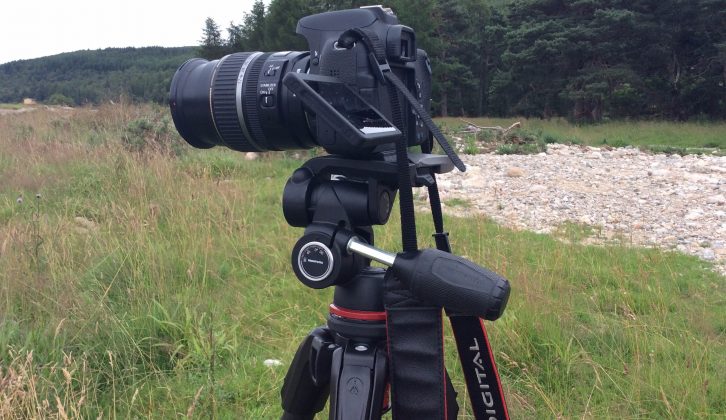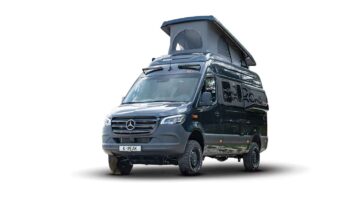Verdict
Being light, strong, easy-to-use and pretty compact, the Manfrotto 190 Go! carbon fibre tripod has a lot going for it if you like taking photos on your motorhome holidays. It’s also suitable for use with a range of cameras.
Just be sure the tripod’s levers are tight and your camera is sufficiently secured.
Pros
It is light and strong
The head attaches easily
It’s easy to carry, with a weight of just 1.35kg
It packs up to 47cm long, so won’t take up much space in your ’van
Cons
Take care to tighten the head’s levers to avoid it slipping on any of its axes
Photographic panorama aficionados and videographers may find the X-PRO geared tripod head to have a more fluid action
Last year we reviewed the Manfrotto 190 Go! tripod and X-PRO geared three-way head, a great choice for keen amateur photographers looking to capture unforgettable images on their motorhome holidays.
And judging by the quality of the reader tour images we publish, we know there are many capable and committed photographers among the motorcaravanning fraternity – and, in particular, the readers of Practical Motorhome.
Designed for digital SLR (single-lens reflex) cameras, the 190 Go! and geared X-PRO head weigh a total of 2.42kg so are light enough not to make a dent in a motorhome’s user payload. The tripod can be carried in a sleeve, or attached to a camera backpack for ease of transportation.
An alternative version of the 190 Go! is the carbon fibre version, which cuts the weight by 0.32kg, making it even lighter for carrying around the great outdoors.
We’ve been fortunate to have had a carbon fibre version of the 190 Go! tripod on long-term test, where we’ve used it for a variety of applications, photographing travel story locations and filming videos for our YouTube channel.
Why use a tripod?
Whether you shoot with a DSLR or compact system camera (CSC), having access to a tripod opens up an extended range of possibilities with the camera. Photographers of landscapes can shoot using smaller apertures, to gain an extended depth of field to ensure most of the image is in focus.
In-vogue techniques like panoramic images are a cinch on a tripod, as you can pan around on the same horizontal axis, therefore making it easier to ‘stitch’ together the final image in software (it’s easier than you think).
It’s also a useful fallback if you’re faced with a dramatic landscape or a sunset shot, but you don’t have a wide enough lens to capture it all. You can take two images with the lens you have, then join it in the middle to create a wider shot.
Shooting the interiors of buildings can also be transformed, but only where the use of a tripod is permitted (permission isn’t always granted when visiting stately homes, museums and other antiquities, for example).
In addition, a longer exposure (generally anything more than one sixtieth of a second) will normally require the use of a tripod to keep the camera steady. It allows you to reduce the ISO value (sensitivity of the sensor) so there’s less noise (grain) in the image.
And a tripod is a must if you’re considering the use of filters for more creative ‘special effect’ photography, for example adding neutral density or polarizing filters, which reduce the light entering the lens.
In all these situations, and especially when using a compact or medium-sized DSLR, one could argue that the lighter the tripod, the better. And carbon fibre tripods meet this brief. It’s a composite material that weighs less than the conventional aluminium, but it is strong, making it ideal for these kinds of applications.
Getting a grip
The Manfrotto 190 Go! carbon fibre is a four-section tripod, which means there are four telescopic sections on each leg. It uses twist grips rather than snap fasteners to lock these sections in place.
This system also allows the user to rotate the individual cuffs and lower or raise the tripod in situ. It’s a more natural action than having to release and snap a fastener in place.
Fully extended, with the central section raised, the tripod is 1.47m high. When the legs are splayed to the fullest extent, and the central column raised, the tripod is approximately 8cm from the ground. This allows you to capture tall subjects in portrait images, as pictured.
Another leading design feature is the ability to lower the central column that supports the camera through its supporting cuff, then rotate this through 90 degrees. This allows the camera to be placed on a horizontal plane above the subject, making it easy to capture still life images.
Perhaps you’ve collected some leaves or shells from your travels and would like to photograph them in detail; the best way of shooting this is to do it from above, using natural light. Just as in its sister product, this system is easy to utilise and is another plus point in the 190 Go! carbon fibre’s feature set.
Great for most applications
We paired the 190 Go! carbon fibre tripod with an X-PRO three-way (tilt, panorama and roll) head with extendable levers.
The X-PRO’s top plate attaches to the camera by means of a quick-release catch, operated by a lever, with a safety catch attached to prevent unwanted detachment. This head will safely support cameras up to 4kg in weight, which will cover most compact and mid-sized cameras with lenses attached.
Although you can use the X-PRO’s levers in their retracted positions, in reality they’re more precise when they’re a small distance away from the camera’s body.
A twist of each of the levers locks them in place, although we found they needed to be locked tightly. The heavier the camera body, the more likely the head will slip on one or more of its axes, and you’d clearly want to protect your camera body from any contact with the ground.
Small circular spirit level displays provide instant feedback on how straight and level the camera is, although some DSLR cameras and CSCs have built-in electronic level displays.
Although we found the X-PRO head easy to use, the version with geared (screw-style) adjustment, with quick-release levers, as tested previously, is more fluid and precise. If this speed of use and extra smoothness isn’t a concern, though, then the X-PRO head will be perfectly adequate for most everyday applications.
Manfrotto tripod heads attach by means of a 1/4in screw with 3/8in thread, then by tightening a small securing screw on the underside of the circular base plate. When a head is not attached to the tripod, then a rubber cap (supplied) can be used to prevent the top of the screw head from becoming damaged.
Light and compact
Other features of the Manfrotto 190 Go! carbon fibre tripod include a hook for hanging a weight (typically a rucksack or camera bag) to secure the tripod in windy or unstable conditions.
They also have a 1/4in screw thread for attaching extenders to the top collar to accommodate professional accessories like video monitors or booms for attaching lights, for example.
The Manfrotto 190 Go! carbon fibre tripod packs down to 47cm (18.5in) long. A sleeve with a drawstring is supplied for transporting the tripod, although in use this was less practical than a sleeve with rucksack-style straps, the like of which Manfrotto previously used to supply with some of its tripods.
Another leading design feature is the ability to lower the central column, then rotate this through 90 degrees















